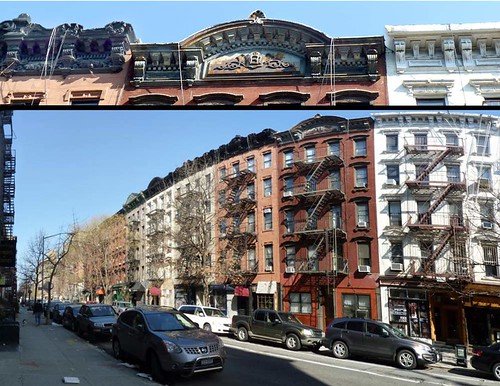Today on The Local, we’re hosting a dialogue about the neighborhood’s proposed historic districts. First, below, Britton Baine and Richard Moses, who serve on the steering committee of the Lower East Side Preservation Initiative, speak out in favor of them. Later, architect Ido Nissani argues that one of the districts would burden and disrespect the synagogue he attends. Add your own thoughts via the comments.
This has been an exciting time for the East Village and its historic architecture. In June, the city Landmarks Preservation Commission calendared for public hearing two new historic districts: the proposed East Village-Lower East Side and East 10th Street districts. In July, after three contentious public hearings, Community Board 3 voted with a strong majority to support landmarking these districts.
The question now is, when will the LPC schedule the hearing date for their designation? For preservationists, sooner is much better than later, because until the LPC votes to landmark the districts, the buildings will not be completely safe from defacement or demolition.
Two questions preservationists have been hearing are, why landmark, and how will landmarking benefit the East Village? There are many reasons.
In terms of the neighborhood’s architecture, the existing building stock – mostly low-rise, tenement-style apartment buildings with their warm brick facades enlivened with amazing displays of stone and terra cotta sculpture, pedimented entryways and ornate wood and metal cornices – is uniquely characteristic of the Lower East Side. Walking through the neighborhood you can still experience the same fantastic architecture and streetscapes that residents experienced 100 years ago.
But there are very few intact blocks of these buildings left. In blocks where the historic buildings are stripped of ornament or demolished and replaced with a jumble of insensitive modern structures, it’s no longer possible to appreciate a visually unified and harmonious streetscape, where each building relates to its neighbors in terms of its scale, materials and visual “texture.” Currently, the LPC is simply seeking to preserve a representative portion of these streetscapes.
In terms of the community’s history, the East Village-Lower East Side has local, national and even international importance, as a large percentage of American families can trace their ancestors’ arrival in this country through the Lower East Side. Beginning in the 19th century, immigrant groups from many countries lived and worked in the neighborhood, and molded its culture. Many of the buildings they built, including tenement apartments, houses of worship, social centers and theaters, still stand today, and many still retain their original uses. It’s still possible to walk past intact rows of historic buildings and visualize the life lived by earlier generations, the immigrants, artists, authors, political activists and musicians who shaped and continue to shape our city and nation.
Although our architectural and cultural heritage is prized by so many, present-day development pressures continue to press harder on the Lower East Side. Even with recent downzoning, historic 19th and early 20th century buildings are still being demolished and replaced with generic developments, or their ornate facades are being stripped and stuccoed into flat unadorned boxes.
As New Yorkers, most of us are apartment dwellers. We live a lot of our lives out in our streets, our parks, and our communities. Our built environment molds this communal experience. When our streetscapes are thoughtlessly damaged or altered, our built environment degraded, the physical record of our history erased, we are diminished as well.
Landmark districts are an attempt to retain a sense of shared communal values that go beyond individual institutions or groups, and beyond the thought of one or another particular building. Of course, change should not and cannot be stopped in its tracks; change is an intrinsic part of New York. But even as population growth, economics, and ever-changing tastes continue to drive architectural change, urban policy tools like historic districts enable us to step back from immediate profit and current fashion and consider historic neighborhoods as cohesive environments with important stories to tell, shaped both by us and those that came before us.




